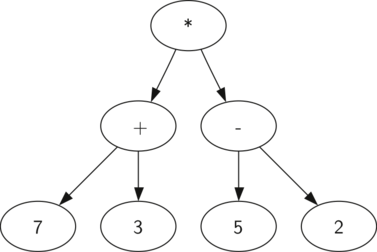Tree Structures
A tree structure is a data structure that represents a hierarchy of elements. They are used in many areas of computer science.
In the previous lecture we discussed expressions. Computers need an algorithm to evaluate expressions. One way to do this is with a tree structure.
Tree Terminology
- Node: Any single element in a tree.
- Root: The top node in a tree.
- Parent: A node that has children.
- Child: A node that has a parent.
- Leaf: A node that has no children.
Tree Traversal
There are many algorithms for determining the order in which to visit nodes in a tree.
We will use a post-order traversal for syntax trees:

In the graphic above, visits are shown in blue, evaluations in red.
Each leaf node (A, C, E, H) would be some operand, and each internal node (B, D, F, G, I) would be some operator.
Abstract Syntax Trees
An abstract syntax tree is a visual representation of the syntax of a programming language for some expression.
Basic Syntax Tree
Below is a syntax tree containing literals and operators for the expression:
(7 + 3) * (5 - 2)
Draw the syntax tree for the following expressions:
1) 5 + 3 * 2
2) (5 + 3) * 2
3) 10 / 2 / 2 - 1
4) 10 / (2 / 2) - 1Variables in Syntax Trees
If a syntax tree includes variables, we treat them just like literals.
- Draw the syntax tree for the expression:
(7 + x) * (y - 2)-
Evaluate the expression for
x = 3andy = 5by plugging in the values.
Expanding Function Calls
We may need to substitute the function call with its definition within the tree. We just drop it in place.
Given the function:
f(x) = x / 2Find the syntax tree for the following expressions:
1) 10 * f(4) + 3
2) 10 * f(y) + 3
3) f(2) * f(3)Function Composition
Function Composition is the process of combining two or more functions to produce a new function.
Arithmetic Function Composition
Given the functions:
f(x) = x + 1
g(x) = x * 2An example of function composition is f(g(x)).
We can use an AST for each function expression, then combine them into larger expressions:

With function composition, the "x" in one function will be replaced by a whole function expression.
Given the functions:
f(x) = x + 1
g(x) = x * 2-
Show the combined AST using the expressions for the two functions above.
-
Evaluate the expression
f(g(3)).
f( g( 3 ) )
= f( 3 * 2 )
= f( 6 )
= 6 + 1
= 7Given the functions:
f(x) = x + 1
g(x) = x * 2-
Show the combined ASTs using the expressions for the two functions above.
Evaluate the expressions:
1) g( f(3) )
2) f( f(2) )
3) f( f( f(6) + 1 ) + 2 ) + 3Functions with Multiple Arguments
Functions can take multiple arguments. In this case, we plug in the values for each argument in the order they are given.
Given the function:
f(x, y) = x + y + 1Evaluate the following expressions:
1) f(3, 4)
2) f(1, 2)
3) f(3, f(2, 1))Boolean Logic in Syntax Trees
We can drop in True and False values into our syntax trees along with logical connectives.
They work the same as we've seen so far.
Draw the syntax tree for the following expressions, evaluating them as you go:
1) True and False or False
2) True and (False or False)
3) not TrueFor the Homework
- Use draw.io to make syntax trees
- Make sure to double check what the question is asking you to do!